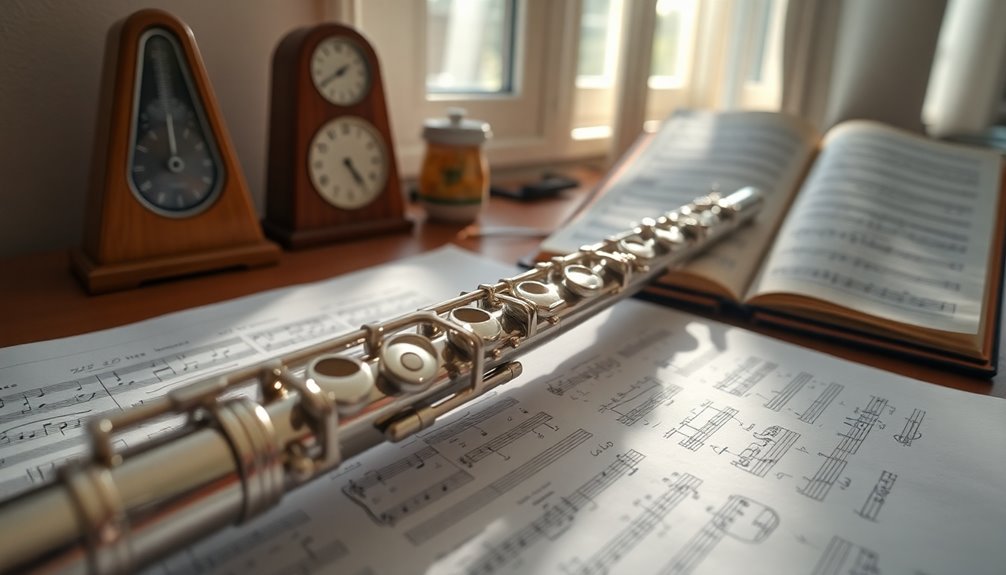You can transform your flute playing by mastering breath control, focusing on tone quality, and improving finger technique. Set clear practice goals and use a metronome to enhance rhythm. Recording your sessions helps track progress and pinpoint areas for growth. Explore ear training to refine pitch accuracy, and don't hesitate to experiment with different repertoires to expand your musical expression. Seek constructive feedback from peers to foster a supportive community that motivates you. By incorporating these techniques, you'll see significant improvement and joy in your playing. Stick around to discover even more valuable tips to elevate your skills!
Key Takeaways
- Practice diaphragmatic breathing to enhance tone quality and sound production in your flute playing.
- Set clear practice goals and incorporate varied techniques to maintain engagement and prevent monotony.
- Utilize a metronome to improve rhythmic accuracy and ensure consistent timing in your performances.
- Engage in critical listening and ear training exercises to refine pitch accuracy and musicality.
- Seek constructive feedback from peers to identify areas for improvement and foster a supportive learning environment.
Master Breath Control

To produce a clear and resonant tone on the flute, mastering breath control is vital. You'll find that effective breath exercises can dramatically enhance your playing. Start by focusing on diaphragm control; this muscle is important for steady airflow. When you engage your diaphragm, you're not just pushing air; you're creating a stable foundation for your sound.
Begin with simple exercises, like inhaling deeply through your nose and exhaling slowly through your mouth. As you practice, try to lengthen your exhalation, aiming for a smooth, sustained tone. You might even use a tuner to monitor your pitch; this can help you understand how breath affects your sound quality.
Incorporate long tones into your daily routine, holding each note for as long as you can while maintaining a consistent volume. This not only builds your lung capacity but also strengthens your ability to control your breath during more complex passages. Additionally, practicing diaphragmatic breathing will further enhance your tone quality and promote relaxation, allowing for effortless playing.
Develop Consistent Practice Routines

Establishing a consistent practice routine is the backbone of your progress as a flutist. To develop your skills effectively, start by setting clear, achievable goals. Whether you want to master a specific piece or improve your techniques, having a target will keep you motivated and focused. Break your goals down into smaller, manageable tasks to tackle each practice session with purpose.
Time management plays an essential role in creating a routine. Allocate specific times for practice in your daily schedule, treating them like important appointments. Consistency is key; even short, focused sessions can yield significant results. Aim for at least 30 minutes a day, and gradually increase your practice time as you feel more comfortable.
Make your routine enjoyable by incorporating a variety of exercises, scales, and pieces that inspire you. This keeps boredom at bay and helps you stay engaged with your flute. Additionally, consider using a metronome to improve your rhythmic accuracy and overall performance quality.
Focus on Tone Quality

Focusing on tone quality is essential for any flutist aiming to elevate their playing. It's not just about hitting the right notes; it's about producing a beautiful, resonant sound that captivates your audience. To achieve this, you need to incorporate tone exercises into your daily practice. These exercises help you refine your sound production and develop a more consistent tone.
Start by experimenting with long tones, playing each note with full breath support and attention to intonation. Focus on maintaining a steady airflow and use your diaphragm to control your breath. As you progress, try varying your dynamics and articulations to explore different colors in your sound.
Incorporating daily breathing exercises into your routine will enhance your airflow control and sound production. Listening is just as vital. Record yourself and listen critically, identifying areas where your tone may lack warmth or clarity. Don't hesitate to seek feedback from peers or teachers who can offer insights into your sound production.
Improve Finger Technique

Many flutists find that improving finger technique can significantly enhance their overall performance. By focusing on your finger movements and hand positioning, you'll release greater agility and precision in your playing.
Start with targeted finger exercises, which are essential for building muscle memory and coordination. Simple patterns, such as scales and arpeggios, allow you to practice moving between notes smoothly and efficiently.
Pay attention to your hand positioning as well. Make sure your fingers are relaxed and curved, hovering just above the keys. This not only helps with speed but also reduces tension, allowing for longer and more comfortable practice sessions. Incorporating the use of finger stretchers can further enhance your finger strength and dexterity.
Experiment with different hand angles to find what feels most natural for you. Incorporate these exercises into your daily routine, and soon enough, you'll notice a significant improvement in your finger dexterity.
Use a Metronome

Using a metronome can dramatically improve your timing and rhythm as a flutist. It's an essential tool that helps you develop rhythmic precision, ensuring you play in sync with yourself and others. When you practice with a metronome, you train your ear and internal sense of timing, which is vital for any musician.
Start by setting the metronome to a slow tempo, and gradually increase the speed as you gain confidence. This method allows you to focus on hitting every note accurately while maintaining a steady beat. The metronome benefits your practice sessions by pushing you to stay disciplined and accountable.
Don't shy away from using it with scales, exercises, or even pieces you're working on. As you become more comfortable, try playing along with different rhythmic patterns or subdivisions. This will deepen your understanding of rhythm and enhance your overall playing experience. Additionally, many musicians find that using a metronome can significantly improve their timing skills, which is essential for maintaining consistent rhythm and developing their musicality.
Explore Dynamic Range

To truly express yourself as a flutist, exploring your dynamic range is crucial. Dynamic contrast allows you to create a tapestry of sound that captivates your audience, transforming simple notes into a powerful emotional experience. Start by practicing scales or melodies at varying volumes. Experiment with playing softly, then gradually increasing your volume, and vice versa. This will help you develop control and sensitivity in your playing.
Pay attention to expressive phrasing; it's not just about how loud or soft you play, but how you shape each note and phrase. Use dynamics to convey feelings—soft passages can evoke tenderness, while powerful crescendos can express excitement or intensity.
Think of your music as a conversation; just as you'd emphasize certain words to convey meaning, do the same with your flute playing.
As you practice, listen to recordings of skilled flutists to identify how they use dynamic range effectively. Embrace the power of dynamic contrast; it's what'll set you apart as a musician. Additionally, mastering breath control techniques will significantly enhance your ability to execute dynamic changes with precision and ease.
Record Your Practice Sessions

Capturing your practice sessions on video or audio can greatly enhance your development as a flutist. By utilizing effective recording techniques, you can create a valuable resource to track your progress and identify areas for improvement.
Whether you choose to record on your smartphone or a dedicated audio device, the goal is the same: to gain insight into your playing.
Once you've recorded your sessions, engage in feedback analysis. Listen carefully to your tone, intonation, and dynamics. This step is essential; it allows you to hear what you mightn't notice in the moment. You may discover subtle nuances that require attention or areas where you're excelling.
Also, don't hesitate to share your recordings with fellow musicians or mentors. Their perspectives can provide additional insights and foster a sense of community, reminding you that you're not alone on this journey. Additionally, experimenting with microphone placement can significantly enhance the quality of your recordings.
Finally, make it a routine. Regularly recording your practice not only tracks your growth but also keeps you motivated.
Over time, you'll see just how beneficial this practice can be in refining your flute skills and building your confidence. So grab that recorder and start documenting your journey today!
Engage in Ear Training

Engaging in ear training is a crucial aspect of becoming a proficient flutist. Developing your listening skills not only enhances your musicality but also boosts your confidence when playing.
By focusing on interval recognition and melodic dictation, you'll deepen your understanding of music and improve your performance. Here are a few techniques you can incorporate into your practice:
- Sing intervals: Start with simple intervals and gradually increase the complexity. This helps you internalize the sounds and recognize them when playing.
- Transcribe melodies: Listen to short pieces of music and write them down. This exercise strengthens your ability to hear and reproduce melodies accurately.
- Use apps: There are several ear training apps available that offer exercises for interval recognition and melodic dictation, making practice both fun and effective.
In addition, regularly practicing intonation exercises can further enhance your ear training by refining your pitch accuracy while playing.
Experiment With Different Repertoires

While exploring various repertoires can seem challenging, it's an essential part of expanding your flute skills and musical expression. By diving into different genres, you open yourself up to new techniques, styles, and emotional depth. Historical context plays a vital role in this journey; understanding the background of a piece can give you insight into its character and nuances.
Start by exploring classical, jazz, folk, and contemporary pieces. Each genre offers unique rhythms, articulations, and phrasing that can enhance your versatility. For instance, the precision needed in Baroque music contrasts sharply with the improvisational spirit of jazz.
As you play through different styles, you'll discover aspects that resonate with you, helping you develop a more personal sound. Engaging with structured progressions can also help you effectively master different techniques and styles.
Don't hesitate to experiment with lesser-known works too. These hidden gems can challenge you and lead to significant growth. Collaborating with other musicians in diverse genres will also enrich your experience, fostering a sense of community.
Seek Constructive Feedback

Your growth as a flutist can greatly benefit from seeking constructive feedback. Engaging in peer review and feedback sessions not only sharpens your skills but also builds a supportive community around you.
It can feel intimidating, but remember that everyone wants to grow together.
Here are a few ways to effectively seek feedback:
- Join a Flute Group: Connect with fellow flutists to share performances and insights. This collaborative environment fosters honest critiques.
- Record Yourself: Listen to your recordings and note areas for improvement. Sharing these with others can spark valuable discussions.
- Ask Specific Questions: When you seek feedback, be clear about what you want to improve—tone, rhythm, or dynamics. This helps others provide targeted advice.
Frequently Asked Questions
What Is the Best Flute for Beginners to Start With?
When you're starting out, choosing the right beginner flute is essential.
Brands like Yamaha and Gemeinhardt offer excellent options that are durable and easy to play.
Look for a flute with a closed hole and a solid silver headjoint, as these features help you develop your technique without frustration.
Don't hesitate to visit a music store and try a few; finding one that feels comfortable will make all the difference in your journey!
How Can I Reduce Hand Fatigue While Playing?
You might think hand fatigue is just part of playing, but it doesn't have to be. Proper hand positioning is essential; keep your wrists relaxed and fingers curved naturally.
Incorporate finger exercises into your practice routine to strengthen your muscles and improve dexterity. Gradually increase your playing time, allowing your hands to adjust.
What Should I Do if My Flute Gets Stuck?
If your flute gets stuck, don't panic!
Start with some flute maintenance tips: make sure the keys are clean and free of debris. Gently wiggle the keys to see if they'll loosen. If they're stubborn, use a small amount of key oil on the hinge.
For stuck keys solutions, consider a professional technician if the issue persists.
How Often Should I Clean My Flute?
You should clean your flute after every practice session to maintain its performance and longevity.
Incorporate cleaning techniques like swabbing the inside with a soft cloth to remove moisture and wiping down the outside to keep it looking pristine.
Establish a maintenance schedule, perhaps weekly, for a deeper clean.
This routine not only prevents build-up but also fosters a sense of belonging in the flute community, showing you care for your instrument.
Are There Any Online Resources for Flute Tutorials?
"Practice makes perfect," and you're in luck! There are plenty of online resources for flute tutorials that can elevate your skills.
You can find excellent flute video tutorials on platforms like YouTube, which offer step-by-step guidance. Additionally, consider enrolling in online flute courses that provide structured lessons and personalized feedback.
These resources foster a sense of community, allowing you to connect with fellow flutists while improving your technique. Immerse yourself and enjoy the journey!
Conclusion
By incorporating these ten techniques into your flute practice, you're setting yourself up for success. Think of your progress like a garden; with consistent care and attention, it blooms beautifully over time. Just as a gardener learns to nurture each plant, you'll discover what works best for you through experimentation and patience. Embrace each practice session as an opportunity to grow, and soon enough, you'll find your music blossoming in ways you never imagined. Keep playing!






